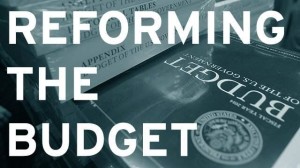Jul
31
A Conservative Blueprint for Reform
“Government is instituted for the common good; for the protection, safety, prosperity, and happiness of the people; and not for profit, honor, or private interest of any one man, family, or class of men; therefore, the people alone have an incontestable, unalienable, and indefeasible right to institute government; and to reform, alter, or totally change the same, when their protection, safety, prosperity, and happiness require it.” -– John Adams, ‘Thoughts on Government’, 1776
 As I’m sure you have noticed, the United States — its businesses, communities, families and individuals — are struggling. We are struggling under mountains of debt, both personal and governmental. We are struggling under innumerable, often ridiculous regulations and increased taxes. We are struggling to feel and stay safe, when our government leaders keep opening borders without proper vetting or restrictions, releasing violent criminals into the populace, and shrinking/weakening our military despite growing international threats. And, that’s just the beginning.
As I’m sure you have noticed, the United States — its businesses, communities, families and individuals — are struggling. We are struggling under mountains of debt, both personal and governmental. We are struggling under innumerable, often ridiculous regulations and increased taxes. We are struggling to feel and stay safe, when our government leaders keep opening borders without proper vetting or restrictions, releasing violent criminals into the populace, and shrinking/weakening our military despite growing international threats. And, that’s just the beginning.
But, much of the struggle is unnecessary, if only our government leaders would abandon the foolish and failed policies that got us here over the past several years. If only they would do what is right for a safe and healthy nation. The Heritage Foundation, with its various specialty institutes, recently published its “Blueprint for Reform: A Comprehensive Policy Agenda”, which is meant not only to educate the American public but to (hopefully) guide the next presidential administration and Congress on how to get government and the nation back on track.
An earlier published “Blueprint for Balance” document provided “detailed recommendations for the federal budget put forth by Congress”. The “Blueprint for Reform” lays out “a long-term vision, and policies to achieve that vision, that requires presidential leadership and congressional action.” This includes “tak[ing] steps to allow Americans to build for themselves a stronger economy, a stronger society, and a stronger defense…. The first six chapters of the Comprehensive Policy Agenda provide policy summaries in the areas of economics, tax, entitlements, regulation, energy and natural resources, and foreign policy and defense. The second section of the book is dedicated to establishing agency and department budgets and policy objectives for the next 10 years.”
But, here’s what it really boils down to:
“The next President of the United States and Congress will face significant challenges in restoring to public life the principles of free enterprise, limited government, individual freedom, traditional American values, and a strong national defense.”
To that end, Heritage recommends beginning with the following proposals, which I have adapted from their slightly longer summaries….
Pro-growth tax reform: The tax system should raise the revenue necessary to fund a limited government at the lowest level possible for constitutionally appropriate activities. It should apply the least economically destructive forms of taxation, have low rates on a broad base, minimize interference with the operation of the free market and free enterprise, and minimize the cost of compliance for taxpayers. It should also minimize adverse impact on the core institutions of civil society. This plan includes establishing a flat tax that eliminates penalties on saving and investment.
 Balance the Budget: The budget should be balanced by driving down federal spending, including through entitlement reforms, while maintaining a strong national defense and not raising taxes. Heritage outlines a plan to accomplish this balanced budget “on a unified basis” by 2024.
Balance the Budget: The budget should be balanced by driving down federal spending, including through entitlement reforms, while maintaining a strong national defense and not raising taxes. Heritage outlines a plan to accomplish this balanced budget “on a unified basis” by 2024.
Reduce Regulatory Burden: Immediate reforms should include the requirement that legislation undergo an impact analysis before a floor vote in Congress; also, every major regulation should obtain congressional approval before taking effect. Sunset deadlines should be required for all major rules, and independent agencies should be subject to the same White House regulatory review as executive branch agencies.
Repeal Harmful Laws, beginning with Obamacare and Dodd–Frank, replacing the former with patient-centered, market-based reforms. Additional reforms should include removing the federal government from housing finance, ending the Federal Reserve’s emergency lending power, and ending federal loan and security guarantees.
Reform Welfare: The current system has failed to improve self-sufficiency of the poor and the cost of the welfare system is unsustainable. Welfare reform should encourage work, a proven formula for reducing dependence and controlling costs. Furthermore, states should gradually assume greater revenue responsibility for welfare programs; that is, they should pay for and administer the programs with state resources. Additionally, leaders should work to strengthen marriage. The absence of fathers in the home is one of the greatest drivers of child poverty. Policymakers should reduce marriage penalties in the current welfare system and find ways to promote marriage in low-income communities.
Rebuild the Military: The risk to Americans everywhere posed by global terrorism, the eruption of conflicts in many regions of the world, and American retreat in the face of challenges have begun to show the American people what a world without America looks like. The ability of the United States to exercise leadership and protect its interests depends substantially on the strength of the U.S. armed forces. The new President and Congress need to allocate the necessary resources to strengthen U.S. military capabilities.
Much of this probably sounds familiar, as many have been shouting the need for many of these and similar reforms for years. But, with their expertise and dedication to Constitutional conservatism, I trust Heritage to put some meat on the bones. At least one conservative columnist, however, has some reservations about Heritage’s recommendations. Constitution.com’s Joe Scudder notes four issues of concern:
1) In a recent video, “Why Trade Doesn’t Cause Unemployment”, Heritage “refused to acknowledge that the middle class is hurting and identify what (rather than trade) is causing the pain.”
2) Their agenda is “not necessarily the same as Trump’s.”
3) “In areas where they do agree, I have to wonder why the Blueprint recommends actions that Congress has refused to take when they were sorely needed.” Here he cites a Diane Katz’s summary at “The Daily Signal” regarding the call for “a variety of regulatory reforms to curtail the vast administrative state”. Scudder predicts that “[t]he moment the Democrats accuse the Republicans of wanting to “shut down” the government, the GOP majority will surrender. That’s how Republicans gave in to Obama’s budget.”
4) The Heritage report brings up our current unpreparedness to confront “Russian adventurism in Eastern Europe [and] Chinese expansion in the South China Sea” in its national defense section. Yet, Scudder point out, these haven’t exactly been hot issues in the public discussion. “It is the mark of disconnected elites to worry about such things rather than our middle class. The man who won the primary condemning our war in Iraq is not likely to get the country entangled in another foreign war—especially not with a nuclear power.”
These are all certainly fair points to bring up, but I think Scudder’s criticisms are off-base. Regarding #1, his concerns were simply tangential to the focus of the 1-minute video. Regarding the rest, those are not good reasons for Heritage to avoid addressing issues that they deem important, even those that aren’t imminent threats or current hot topics with the public or the candidates. While I haven’t gone through the “Blueprint”, I also doubt that they ignore the concerns of the middle class.
Heritage will release a third report later this year which “will identify presidential and Cabinet-level priorities for reforming major agencies consistent with the policy proposals presented in the first two parts of the Mandate series.” Meanwhile, for a few more details and a direct link to the 152-page “Blueprint for Reform”, see the Heritage article here: “Blueprint for Reform: A Comprehensive Policy Agenda for a New Administration in 2017”.
In the end, all the Heritage Foundation can do is provide information and expert advice. It is up to Congress and the new President to evaluate it and (hopefully) take appropriate action.
















